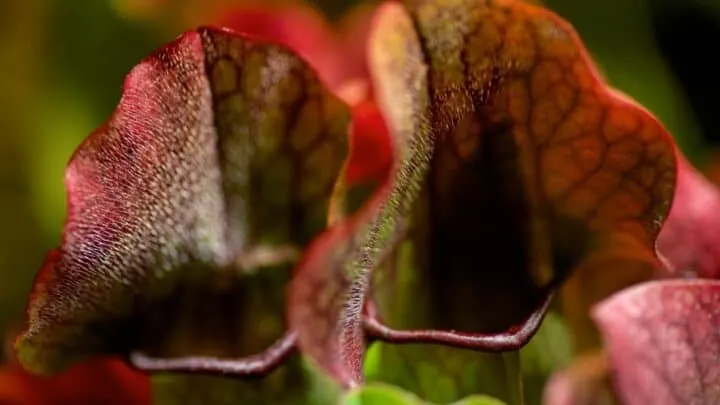There are more than a thousand species of carnivorous plants all over the world.
These plants are native across all the continents, other than Antarctica.
Carnivorous plants are unlike any other plants as they catch bugs to feed on them.
While other plants get fed, these plants tend to feed on pests that come to them for food.
If you wish to grow some easy carnivorous plants, then try a few from this list.
Easy to Grow Carnivorous Plants
- Venus Flytrap
- Cape Sundew
- Spoonleaf Sundew
- Butterwort
- Tropical Pitcher Plant
- Aldrovanda
- Purple Pitcher Plant
- Bladderworts
- Lobster-pot plants
- Catapulting Flypaper Trap
- Yellow Trumpet
1. Venus Flytrap (Dionaea Muscipula)
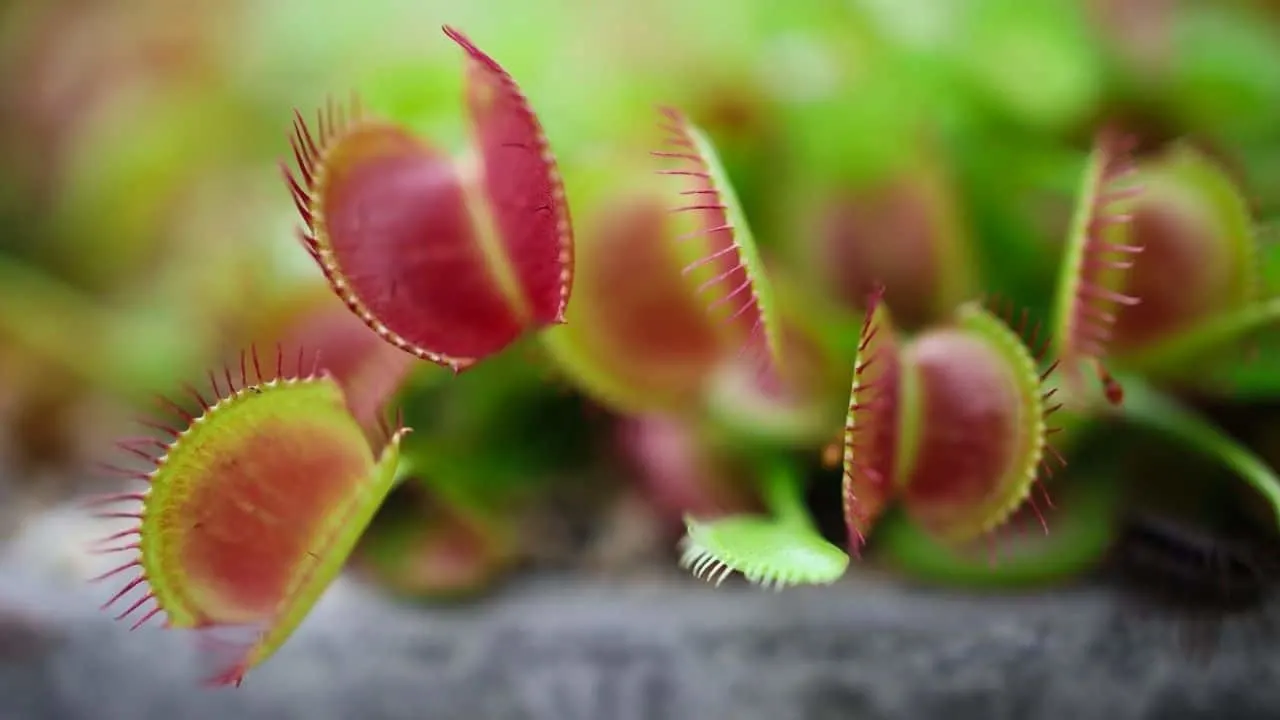
This is the most popular and well-known carnivorous plant. Venus flytraps have strong “jaws” that trap flies and other insects once they touch the hair present in its pink center.
This plant benefits from eating insects, and then the plant gets nitrogen and other nutrients from the digested insects.
Venus flytrap feeds on insects because the soil it grows in has insufficient nutrients, and basic insects around the plant can provide these nutrients.
- Common name: Venus Flytrap
- Scientific name: Dionaea Muscipula
- Family: Droseraceae
- Max height: 6 to 12 inches tall by 6 to 9 inches wide
- Soil: standard soil mixture (1 part peat moss and 1 part perlite)
- Lighting: bright but indirect light
- Growth rate: grows 4 to 5 inches in two to four years
- Fertilization: This does not need fertilization.
- Temperature: 70 to 95 degrees Fahrenheit (21 to 35 degrees Celsius)
- Hardiness zones: 8-10
This plant is trendy amongst kids, so if you grow it at home and have children around, make sure they do not touch it often. Venus fly traps are pet-friendly plants. They are also non-toxic to animals.
This is because touching it too often will cause the Venus Flytrap to stop working.
2. Cape Sundew (Drosera capensis)
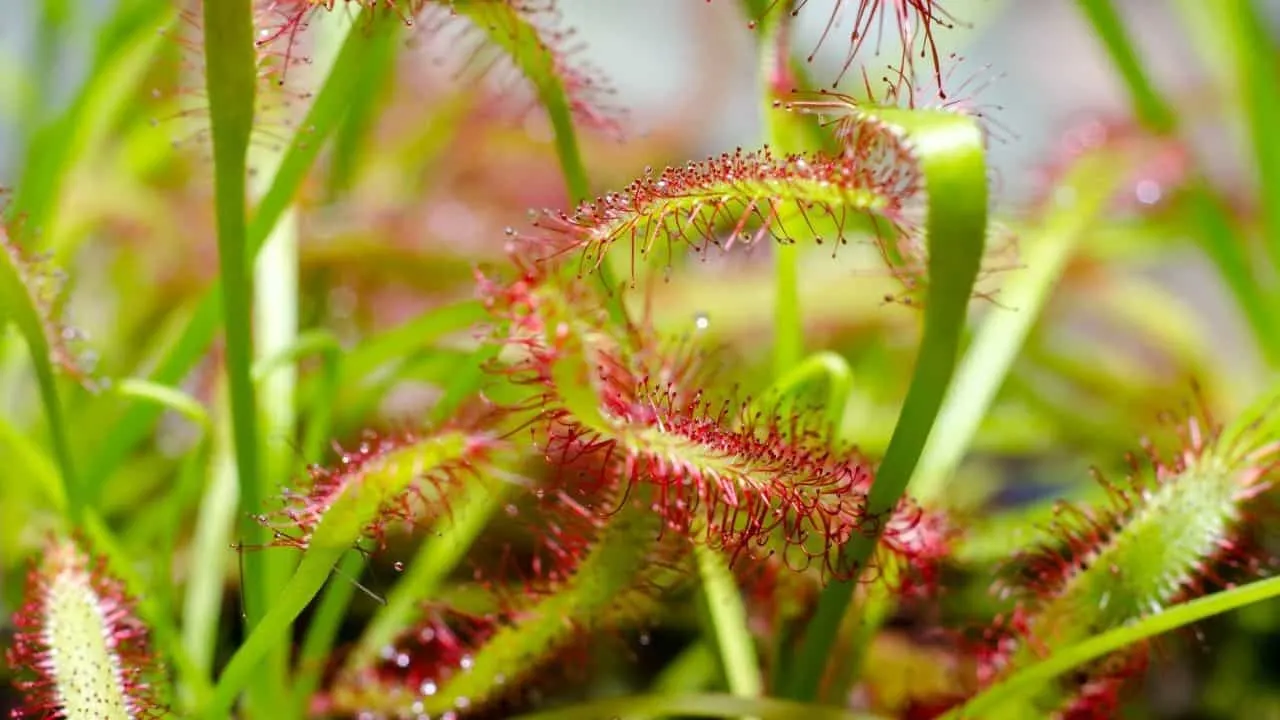
Cape Sundew is another species of carnivorous plant that can be grown as a houseplant. It is able to trap insects by wrapping them up in its sticky leaves.
This is a fairly small plant, and it produces violet flowers in summer. So it might look beautiful, but be careful; it is still a carnivorous plant.
- Common name: Cape Sundew
- Scientific name: Drosera Capensis
- Family: Droseraceae
- Max height: 10 inches
- Soil: sandy peat moss soil mix
- Lighting: Full to partial sunlight
- Growth rate: Fast, grows mature within less than a year
- Fertilization: Goldfish flakes can be used
- Temperature: 60-75 degrees Fahrenheit (16-24 degrees Celsius)
- Hardiness Zones: zone 6
Cape sundew grows easily and reseeds with no trouble. Thus, you will be able to produce several plants from just one.
They enjoy staying under bright sunlight but make sure to remove them from direct sunlight once they get six hours of the early morning sunlight.
3. Spoonleaf Sundew (Drosera spatulata)
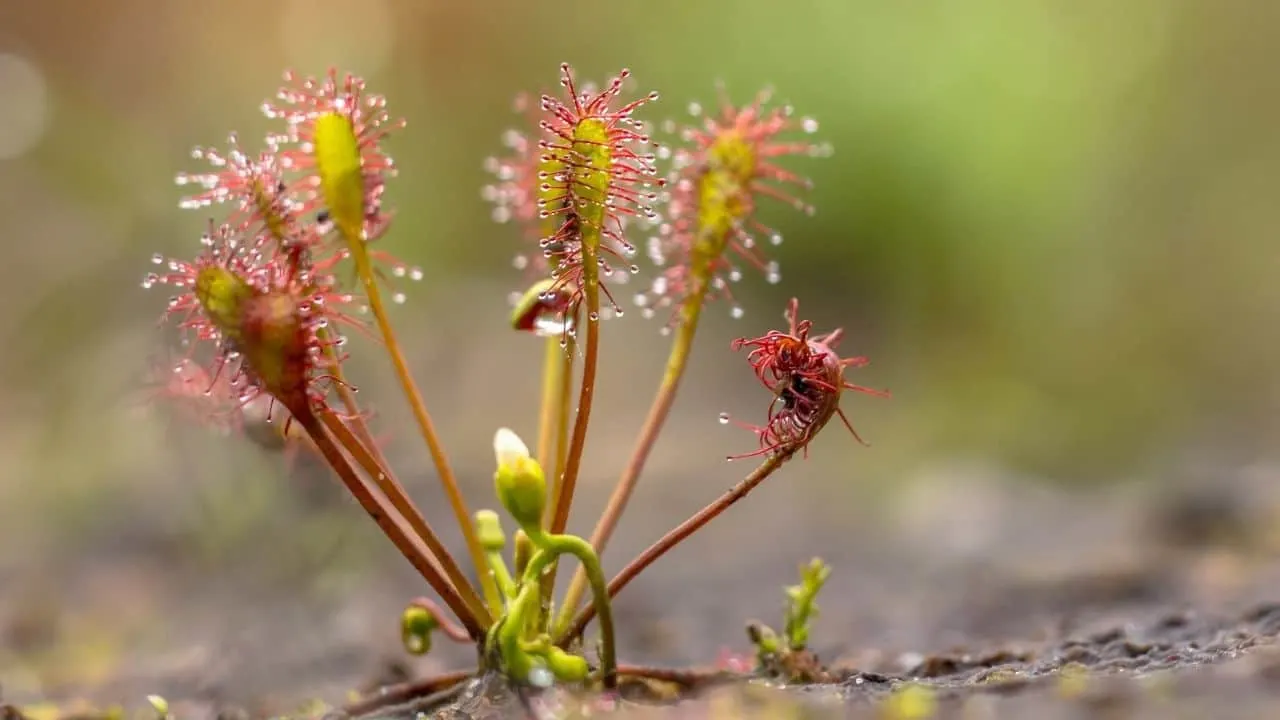
Spoonleaf Sundew is a stunning carnivorous plant that uses its leaves to trap insects. This plant does not grow a lot in height or width.
Spoonleaf Sundew can be found in beautiful colors like orange, red, and maroon. This plant also produces pink and white flowers.
- Common name: spoon leaf sundew, oblong-leaved sundew, or spatulate-leaved sundew
- Scientific name: Drosera Intermedia
- Family: Droseraceae
- Max height: two to eight inches tall (five to twenty centimeters)
- Soil: 1-by-1 ratio mix of peat moss and sand/perlite
- Lighting: Full to partial sun; provide it with six hours of direct sunlight as well
- Growth rate: will grow to maturity within a year
- Fertilization: does not need fertilizer, or you can dilute the fertilizer and use it
- Temperature: 60 to 85 degrees Fahrenheit (15.5 to 29.4 degrees Celsius)
- Hardiness Zones: Zone 10
Spoonleaf Sundew also grows fast and can be grown through reseeding as well.
This is considered one of the easiest carnivorous plants to take care of. It will give you minimum trouble when it comes to plant maintenance.
4. Butterwort (Pinguicula vulgaris)

Butterwort is another small carnivorous plant with yellowish-green sticky leaves, and it traps insects on these damp leaves to consume them.
It also produces flowers in white and purple colors.
- Common name: Butterwort
- Scientific name: Pinguicula
- Family: Lentibulariaceae
- Max height: 1.1 to 6.3 inches (3–16 cm)
- Soil: three parts peat moss to one part clean, and sharp sand (moist to wet soil)
- Lighting: sun to partial shade
- Growth rate: normal
- Fertilization: does not need fertilizer. But to boost growth, basic plant fertilizer can be used.
- Temperature: 77 to 95 degrees Fahrenheit (25 to 35 degrees Celsius)
- Hardiness Zones: USDA zones 10 and 11
Butterwort is known to grow best under partial sunlight, but providing it with six hours of direct sunlight will boost its growth.
When Butterwort has gone into its dormant phase, it will stop catching its prey, so let it dry out in a dark spot.
5. Tropical Pitcher Plants (Nepenthes spp.)
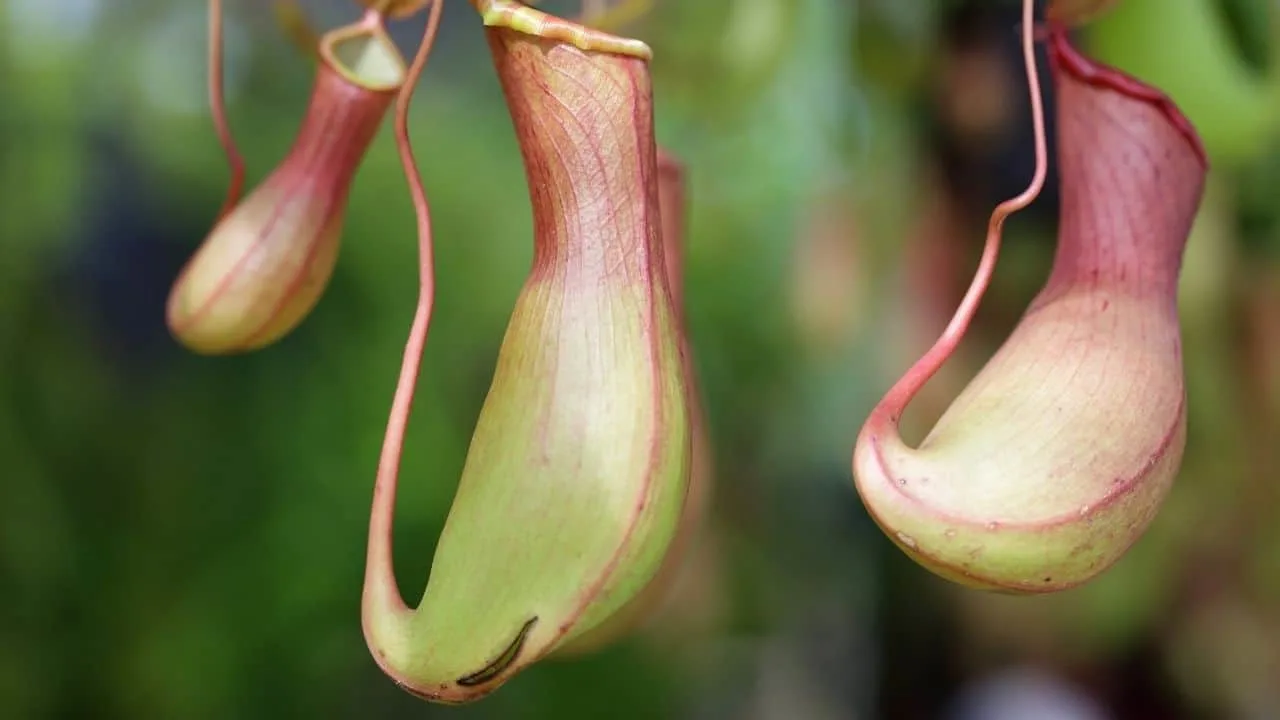
Tropical Pitcher Plants are another intriguing species of carnivorous plants. They have sticky sap that will lure insects, and these plants trap them.
These plants are much deadlier than other carnivorous plants, as they can trap small worms, lizards, and even spiders.
So if you want to grow them, you must be extra careful.
- Common name: monkey cups or Tropical Pitcher Plants
- Scientific name: Nepenthes
- Family: Nepenthaceae; Dumort.
- Max height: 45 feet (13.7 meters)
- Soil: half perlite and half-dry sphagnum moss
- Lighting: bright light without much direct sun
- Growth rate: moderate
- Fertilization: generally not required
- Temperature: 75 to 83 degrees Fahrenheit (23.9 to 28.3 degrees Celsius)
- Hardiness Zones: Zones 6–9
Tropical Pitcher Plants are generally grown in soil that is low in nitrogen, and just like many other carnivorous plants, they too fulfill this lack of nutrients through the digestion of insects.
When you grow this plant outdoors, they will also catch falling leaves and digest them as this helps them gain nitrogen.
So, if you want your tropical pitcher plants to grow healthy, better test your soil’s nitrogen levels first — just to be on the safe side.
6. Aldrovanda
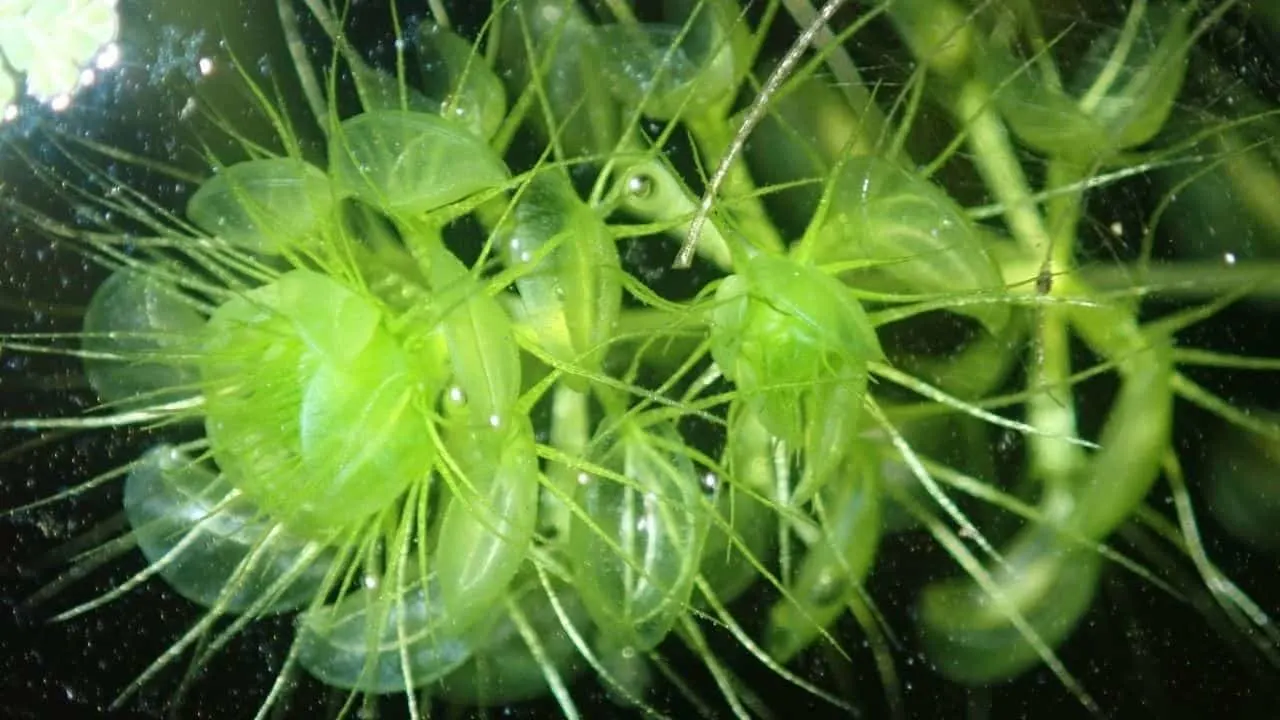
Aldrovanda is a naturally growing plant found in acidic ponds and lakes. It can mostly be found in Japan, India, Europe, Australia, and Africa.
Aldrovanda floats underwater along with other aquatic plants.
- Common name: Waterwheel plant
- Scientific name: Aldrovanda Vesiculosa
- Family: Droseraceae
- Max height: about 1.5 to 20 cm
- Soil: clear to brown water with low minerals and high CO2 concentration
- Lighting: full sun
- Growth rate: fast. grows 4 to 9 mm per day
- Fertilization: does not need it
- Temperature: 61 degrees Fahrenheit (16 degree Celsius) to 90 degrees Fahrenheit (32 degree Celsius) during the growing season and 5-to-86-degree Fahrenheit (-15 to 30 degrees Celsius) tolerated
- Hardiness Zones: 5-9 (4-10)
This plant is easy to grow, but most people do not consider growing it since it’s a water plant.
This is why it is getting closer to extinction as well.
7. Purple Pitcher Plant (Sarracenia purpurea)
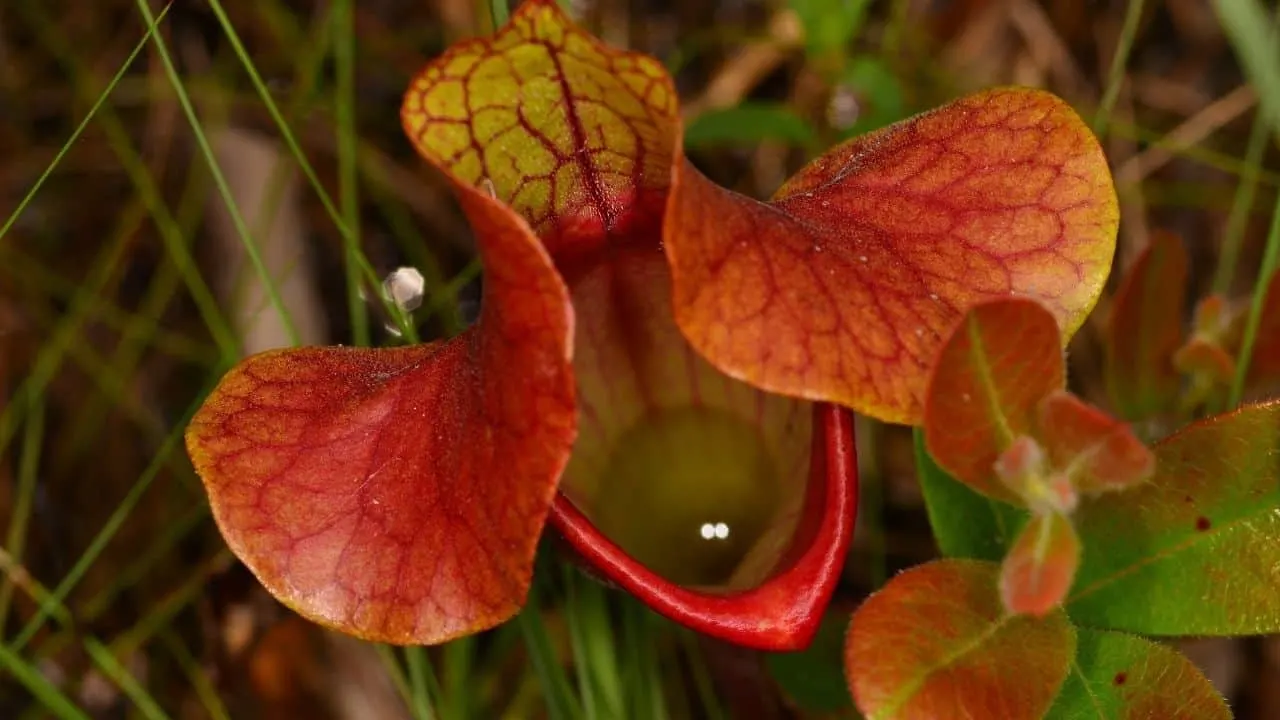
Purple Pitcher Plant is a stunning carnivorous plant that could fool anyone into thinking it is just some pretty flowers.
This plant is even the flower emblem of 2 provinces in Canada, Newfoundland, and Labrador.
This plant can survive under low temperatures and is very easy to grow. It has a very particular way of catching its prey.
It fools the insects by attracting them to its bright colors and scent at the opening of the plant.
When insects come close, some of them lose their footing and fall into the pitcher, where the plant digests them for nutrients.
- Common name: side-saddle flower, northern pitcher plant, turtle socks, or the purple pitcher plant
- Scientific name: Sarracenia purpurea
- Family: Sarraceniaceae
- Max height: 1 to 2 feet
- Soil: half-perlite and half-dry sphagnum moss
- Lighting: full sun to light shade
- Growth rate: Slowly
- Fertilization: Do not need fertilization
- Temperature: 60 degrees to 70 degrees Fahrenheit (15.6 to 21 degrees Celsius)
- Hardiness Zones: 3 – 9
Like other plants that can grow in cold temperatures, the Purple Pitcher Plant also goes through dormant periods where it does not grow, so do not worry when you feel like your plant has stopped growing.
8. Bladderworts (Utricularia)
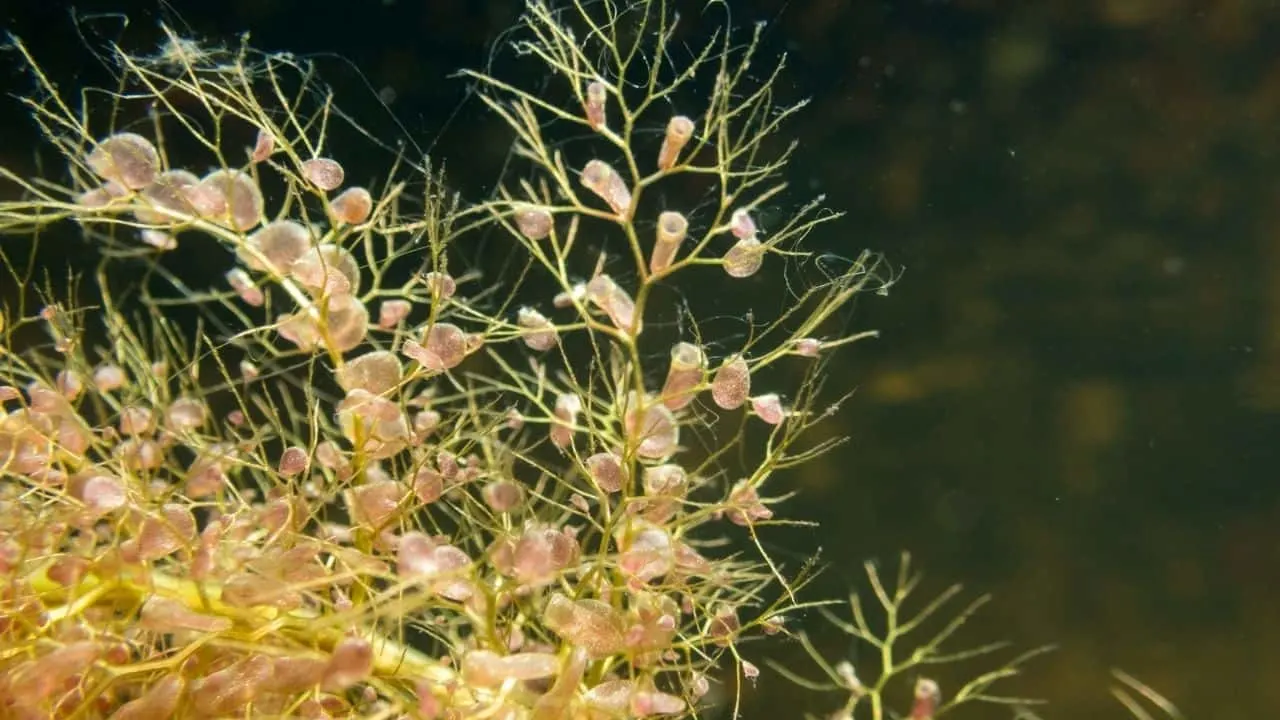
Bladderwort is a plant that was named after its “tiny bladders.”
This carnivorous plant lives in open water and traps its prey in its bladder.
- Common name: Baldderworts
- Scientific name: Utricularia
- Family: Lentibulariaceae
- Max height: 27.6 inches (70cm high)
- Soil: found in lakes, rivers, streams, interdunal ponds, and wet marshes
- Lighting: Bright lighting
- Growth rate: Slow
- Fertilization: does not need fertilizers
- Temperature: 40 to 90 degrees Fahrenheit (4.4 to 32 degrees Celsius)
- Hardiness Zones: 4-8
The tiny hairs on this plant are feelers that let it know that there is an insect it can catch in its trap.
Once the insect gets trapped, the bladderwort sucks water in and eats the insect.
9. Lobster-pot plants (Darlingtonia californica)
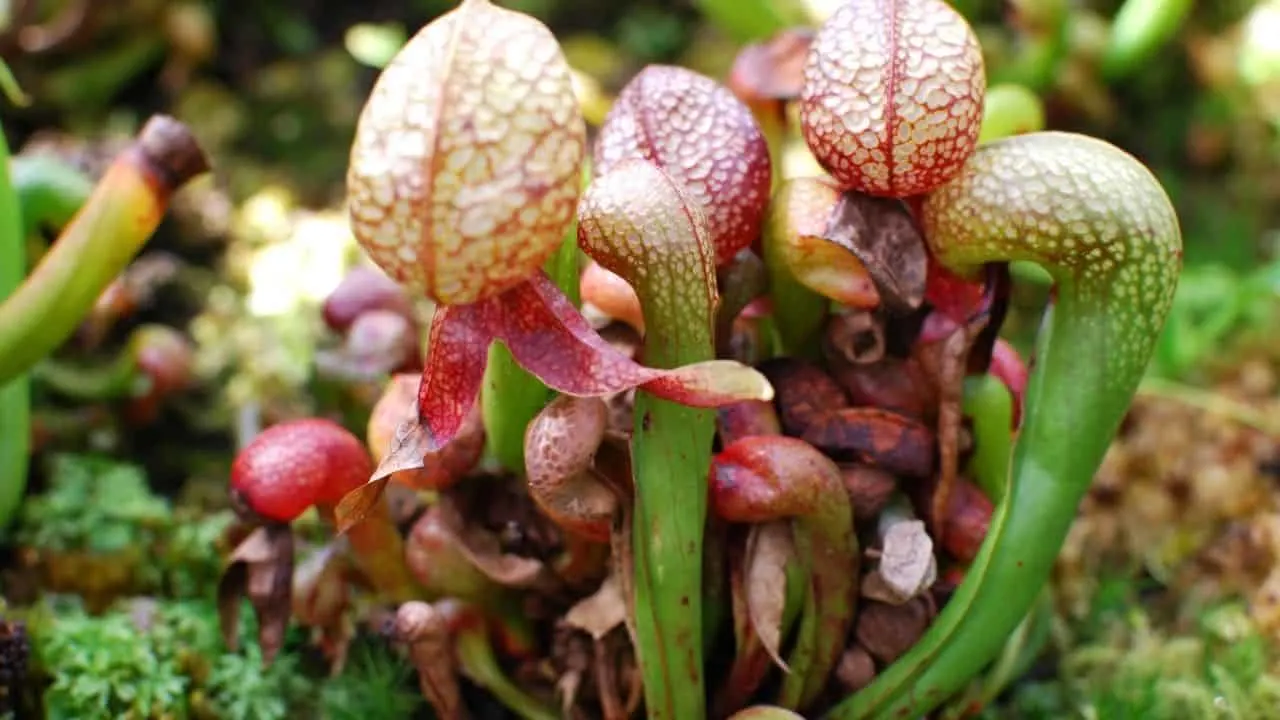
This plant was named after pot fishermen who capture lobsters. This plant captures its prey in its trap which looks like a lobster pot.
Therefore, it is an intriguing plant.
- Common name: cobra lily, cobra plant, or California pitcher plant
- Scientific name: Darlingtonia Californica
- Family: Sarraceniaceae
- Max height: 12 to 36 inches (30 to 90 cm)
- Soil: sphagnum moss to one part pumice or lava rock
- Lighting: strong light
- Growth rate: 3 to 4 inches after three years
- Fertilization: does not need fertilizers
- Temperature: 104 to 131 degrees Fahrenheit (40 to 55 degrees Celsius)
- Hardiness Zones: USDA Zone 7a
When an insect gets trapped in this plant, it won’t be able to find its way out of it.
The tiny hairs on the plant cause the insects to go down into the plant, where they get digested.
10. Catapulting Flypaper Trap
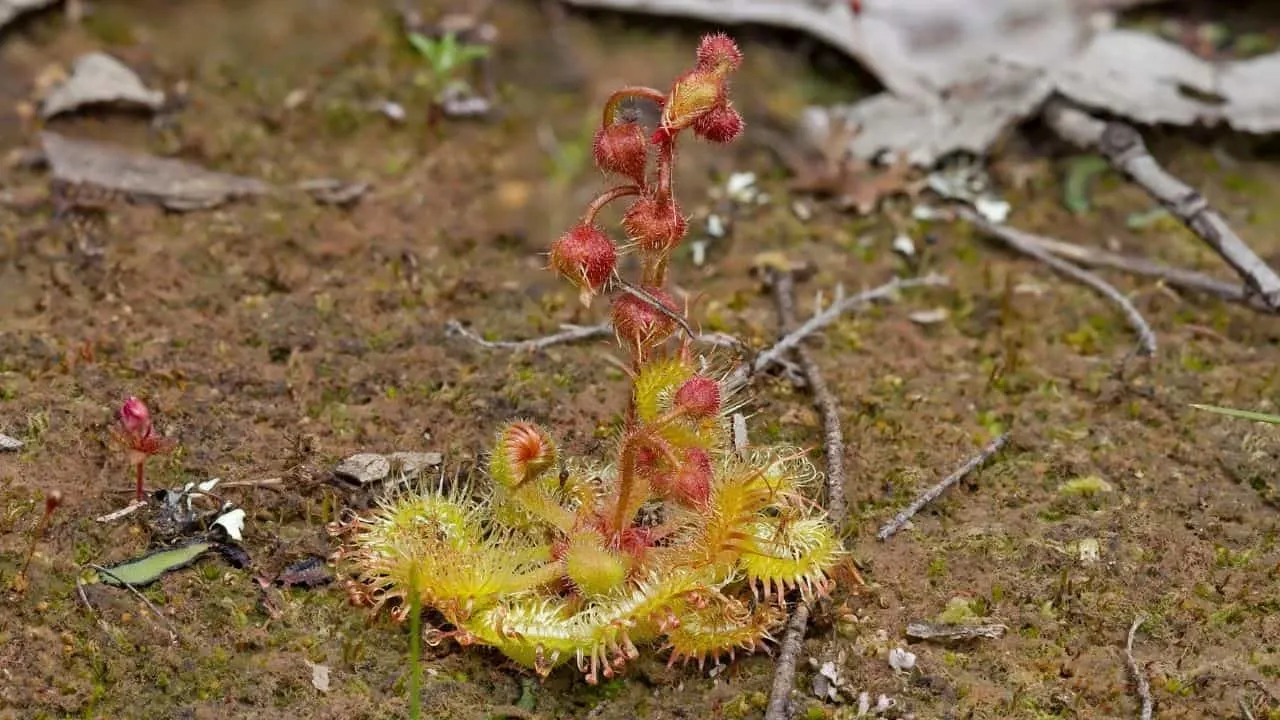
Drosera glanduligera, or Catapulting Flypaper Trap, is a stunning carnivorous plant with qualities of a flypaper plant, such as Butterworts, and has Venus flytrap abilities.
It is found in Australia, and it traps its prey with stinky “tentacles” present on the plant’s outer part.
- Common name: Common Scarlet Sundew
- Scientific name: Drosera Glanduligera
- Family: Droseraceae
- Max height: 1–2 inches (2.5–6 cm)
- Soil: basic potting mix
- Lighting: partial to full sunlight
- Growth rate: medium
- Fertilization: Does not need it.
- Temperature: 60 to 78 degrees Fahrenheit (15 to 25 degrees Celsius)
- Hardiness Zones: 10
Catapulting flypaper trap grows mostly during winter and can germinate through seeds.
Younger catapulting flypaper traps are known to eat springtails, while mature ones eat flies. Its trapping mechanism is unique as it blends the features of both flypaper and snap traps.
11. Yellow Trumpet (Sarracenia Flava)
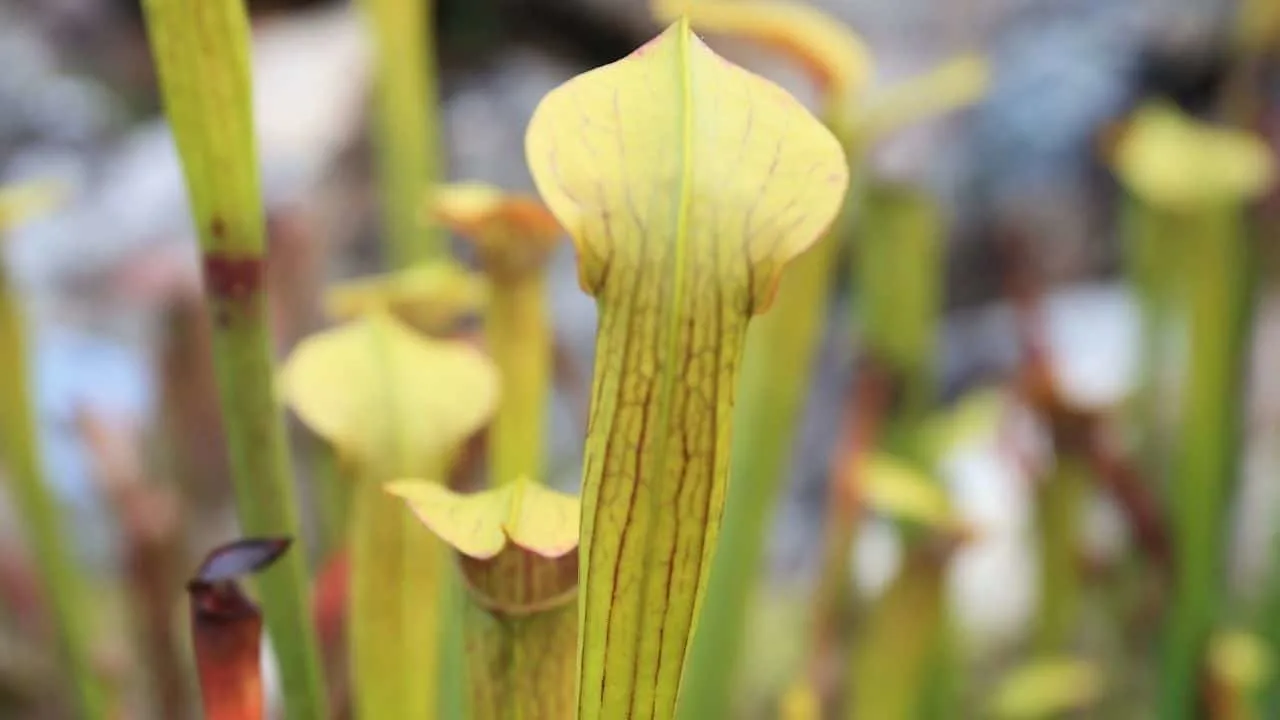
This is a stunning plant known for its bright yellow flowers and trumpet-shaped leaves that are green and held upright.
This plant has a rich and strong fragrance that attracts insects and even humans.
But don’t worry; it cannot harm humans like insects. This plant can only hurt you if it is ingested.
- Common name: yellow pitcher plant or yellow trumpet
- Scientific name: Sarracenia Flava
- Family: Sarraceniaceae
- Max height: over a meter (3 ft) in height, but mostly it grows (50 cm) 20 inches.
- Soil: soil mix of 60% peat moss and 40% sand.
- Lighting: Partial sunlight. Provide it with 6 hours of direct sunlight.
- Growth rate: slow
- Fertilization: does not need fertilizers
- Temperature: During winters, 41 to 59 degrees Fahrenheit (5 and 15 degrees Celsius) and 68 to 104 degrees Fahrenheit (20 to 40 degrees Celsius) in summers.
- Hardiness Zones: 6 – 10
You must always keep the soil moist or wet for this plant. Never let the soil dry out, and make sure the pH remains acidic.
Seeds can also propagate this plant, and it will not flower for the first four to five years of its growth, so don’t stress if you do not see the gorgeous flowers on it soon.
Conclusion
All carnivorous plants aim to eat insects around them. Their main goal is to feed themselves to survive.
They only consume insects to make up for nutrients they cannot get from the soil.
Much like other normal plants, carnivorous plants also go through photosynthesis.
If you want to grow some carnivorous plants, make sure to research well on them, as well as the best soil to grow your carnivorous plants in.

Daniel has been a plant enthusiast for over 20 years. He owns hundreds of houseplants and prepares for the chili growing seasons yearly with great anticipation. His favorite plants are plant species in the Araceae family, such as Monstera, Philodendron, and Anthurium. He also loves gardening and is growing hot peppers, tomatoes, and many more vegetables.

